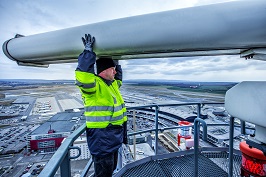 The EU released new legislation in March 2017 which requires member states to adopt a common competence scheme for the Air Traffic Safety Electronic Professional (ATSEP) from January 2020.
The EU released new legislation in March 2017 which requires member states to adopt a common competence scheme for the Air Traffic Safety Electronic Professional (ATSEP) from January 2020.
Regulation (EU) No 373/2017 harmonises the ATSEP personnel requirements including the training and competence keeping requirements, and replaces the patchwork of national regulation and/or intra-company rules relating to ATSEP training, competences, and authorisations.
The ruling reflects work already underway by FAB CE member states to facilitate  harmonisation of personnel requirements for ATSEPs across the region. The Human Resources Sub Committee (HR SubC) developed a baseline plan for the implementation of the Common Competence Scheme, known as Deliverable 11 (D11), in 2015. HR SubC is now tasked with updating this document in line with the latest ruling, and with setting up a task force to prepare and deliver an ATSEP common competence scheme for FAB CE member states. “The same criteria applies to all ANSPs for the recruitment, training and assessment of ATSEPs, so it makes sense to do this work together,” says Matej Eljon, FAB CE Programme Manager and Director of FAB CE Aviation Services, the body set up to run FAB CE activity. “Each ANSP can benefit from a wider pool of qualified engineers, and be confident they operate to recognised standards.” FAB CE was the first FAB to publish a baseline ATSEP plan and continues to lead the delivery of a common competence scheme.
harmonisation of personnel requirements for ATSEPs across the region. The Human Resources Sub Committee (HR SubC) developed a baseline plan for the implementation of the Common Competence Scheme, known as Deliverable 11 (D11), in 2015. HR SubC is now tasked with updating this document in line with the latest ruling, and with setting up a task force to prepare and deliver an ATSEP common competence scheme for FAB CE member states. “The same criteria applies to all ANSPs for the recruitment, training and assessment of ATSEPs, so it makes sense to do this work together,” says Matej Eljon, FAB CE Programme Manager and Director of FAB CE Aviation Services, the body set up to run FAB CE activity. “Each ANSP can benefit from a wider pool of qualified engineers, and be confident they operate to recognised standards.” FAB CE was the first FAB to publish a baseline ATSEP plan and continues to lead the delivery of a common competence scheme.
D11 set out the requirements and processes for obtaining and maintaining ATSEP personnel competency across FAB CE ANSPs. It created a ‘raw model’ for the harmonisation of recruiting, training and authorisations for ATSEP staff based on the existing practises already in use by member states. HR SubC has also carried out a gap analysis to see where practices by individual states are at variance with the raw model. The SubC is now working with ANSPs to define the scope of a common scheme, for example identifying common requirements to enter the profession, common training content, and common qualifications. The SubC is also working through the Social Dialogue forum. Participants in the Social Dialogue provide information and views on all FAB CE developments and issues, in particular focussing on those directly affecting employees. On the employer side, the FAB CE ANSP CEO Chair represents FAB CE ANSP management, while FAB CE staff are represented by bodies representing FAB CE employees. After each meeting, CEOC and staff representatives issue joint and agreed communication through appropriate channels to the FAB workforce.
A workshop during Q4 2017 will review different scenarios, and enable the HR SubC to set up a project plan and appoint a task force with assign resources. The workshop is an important milestone in setting the future pathway for a common competence scheme.
HR SubC chairman Zoran Jakšić says the project delivers a number of FAB CE Strategic Objectives (FSO), set out by the FAB CE Steering Committee. In addition to common training amongst ANSPs, it contributes to a common approach to technical operation and preventive maintenance of systems, rendering the service quality more predictable while potentially making instructor cost savings available.
The ATSEP common competence scheme also benefits from an initiative set up by FAB CE, subsequently expanded to include some FABEC members, to harmonise assessments for ATSEP INITIAL training. The QUestionnaire for ATSEP Standard Assessment Routine (QUASAR) aims to develop a standard questionnaire to assess the level of ATSEP training achieved. The initiative has attracted a lot of ANSP interest since it formed in 2015 - NATS UK recently joined - with ANSPs exchanging question banks and sharing assessment material. QUASAR achieved a milestone in March 2017 when it finalised a questionnaire designed to assess if an engineer has passed the BASIC level of training. It can be used to determine if an ATSEP can progress to domain qualification training in more specialised fields of ATC maintenance. On acceptance of the final version, all member countries will be able to start with implementation of the QUASAR standard assessment for ATSEP-BASIC. The task force also intends to make the assessment public so it can be promoted to other interested organisations.
“The QUASAR task force is a trans-FAB group which over the years has been working very successfully as a self-organised, active group,” says Jakšić. “The task force is now looking to set up a generic working concept for QUALIFICATION training.” It aims to populate question banks for each of the DOMAIN training areas including communication, navigation, surveillance, data processing, and system monitoring and control will need added contribution from individual members. The task force is also looking to enlist the support of the Project Support Office (PSO), which provides administrative and consultative support to FAB CE Aviation Services.
Further support for the ATSEP common competence scheme is provided by the FAB CE Technical Sub Committee (TEC SubC). This includes providing ATSEP expertise as needed and verifying tasks are aligned with current practice. Input from ATSEPs ensures the common competence scheme is based on operational experience, and reflects the practical requirements of ANSPs. The HR SubC is already well versed in the process, having already completed the common competence scheme for air traffic controllers (ATCOs), airspace management position (AMP), and flow management position (FMP) staff in 2015. This was achieved well in advance of EU regulation 340/2015 which came into force in January 2017.
The HR SubC plans to include National Supervisory Authority (NSA) participation from member states in 2018, starting with a follow-up workshop during Q1/Q2 2018 which will review draft content prepared by the task force. The aim is to prepare a final version of the ATSEP common competence scheme for ANSP review in Q4 2018, followed by approval from the Steering Committee and CEO Committee by the end of the year.
